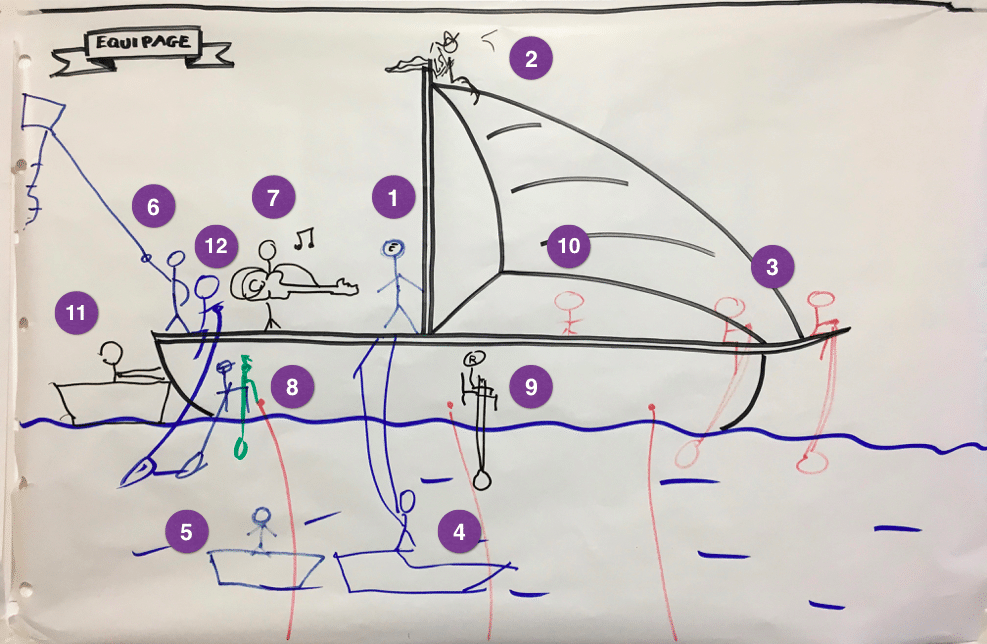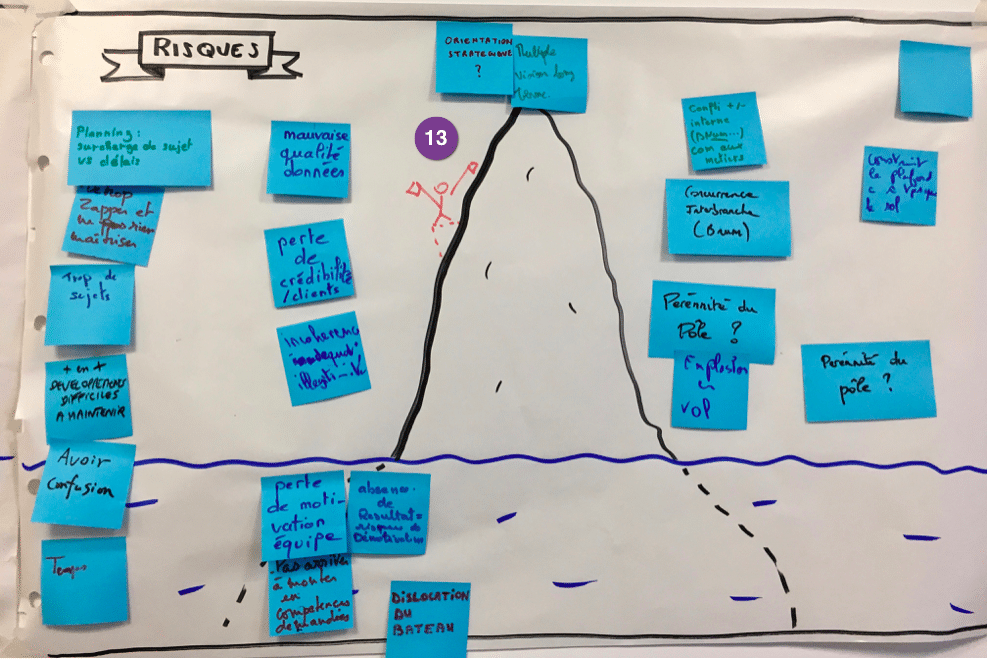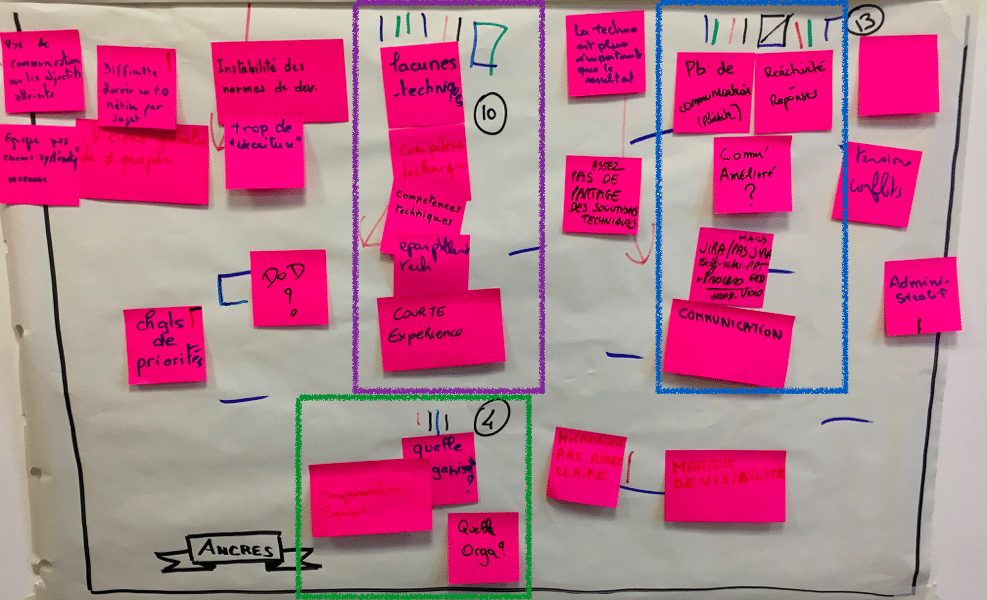
Photo by Bethany Legg on Unsplash
Travaillant actuellement beaucoup sur la montée en compétences de coachs internes chez mes clients, j’apporte avec plaisir mon soutien à des coachs en devenir au sein de la communauté Agile. Sans pour autant prétendre avoir la vérité absolue, je partage avec eux simplement ce que j’ai appris que ce soit en terme de posture, d’outils ou de techniques.
Ainsi je me suis dis que comme dans « le souci du cadre pour maximiser les résultats » – où je décrivais mon cheminement pour structurer un workshop client – je pourrais faire de même pour décrire mon raisonnement en terme de stratégie de coaching !
Qui dit coaching, dit questionnement, c’est pourquoi je vous propose avant tout un partage des questions que je peux me poser ou celles que je peux être amené à poser ! 😛
Premier cas d’étude : un démarrage d’équipe au format Speed Boat ! Bonne lecture 🙂
Pourquoi le Speed Boat ?
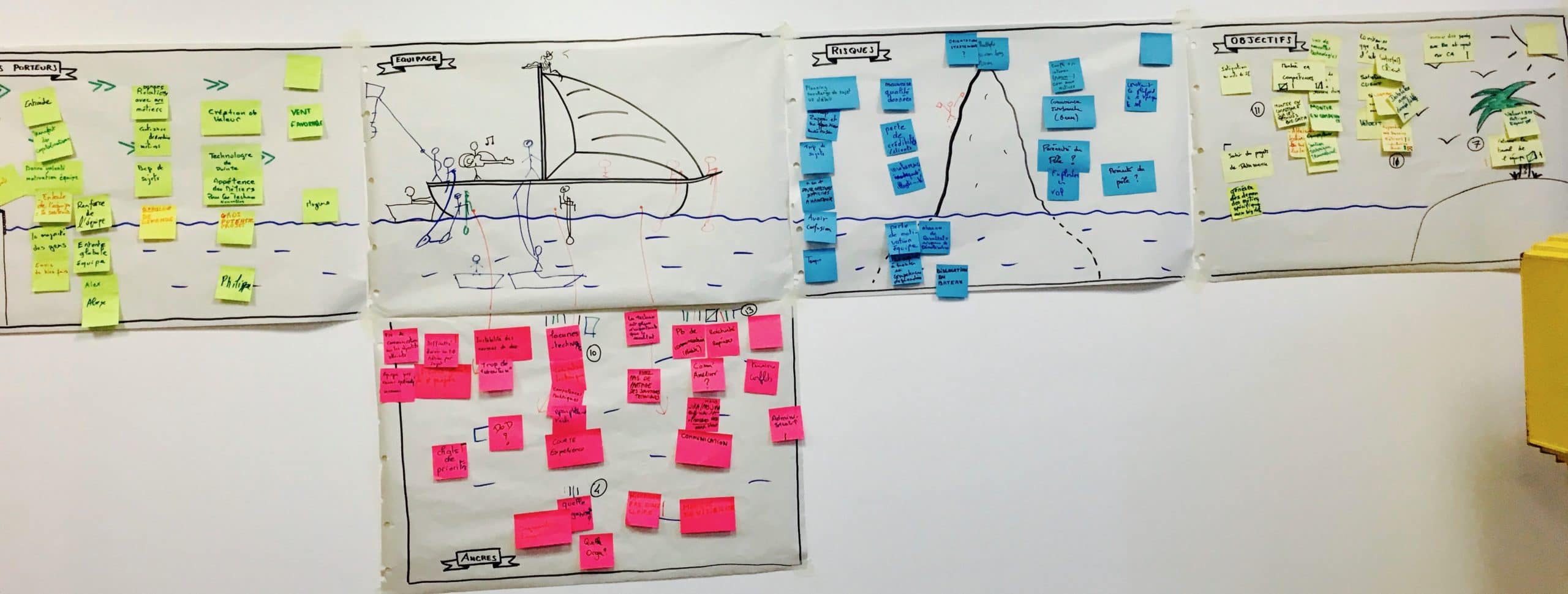
Le Speed Boat est un format d’atelier que j’affectionne tout particulièrement. En effet, son caractère métaphorique permet généralement aux participants de s’exprimer plus librement : la distanciation apportée par le story-telling y est pour beaucoup et le fait de voir l’image se construire au fur et à mesure donne un cadre sécurisant pour s’y engager.
En tant qu’accompagnant, j’utilise souvent ce format lors d’un démarrage d’équipe car j’ai besoin d’obtenir différents types d’information :
- Des informations liées au contexte de l’équipe : les forces (vents porteurs), ralentisseurs (ancres), risques (iceberg) et objectifs (île)
- Des informations liées à l’équipe elle-même : interactions, rôles, ressentis…
La première partie est plus naturelle car au coeur du déroulé de l’atelier, la seconde nécessite de creuser un petit peu plus sous la surface : c’est là que la métaphore prend toute son ampleur !
C’est pourquoi j’invite également les participants à se représenter sur le bateau en expliquant :
- ce qui fait qu’ils se représentent de cette manière,
- à cet endroit,
- quel rôle ils ont dans l’équipage,
- et ce qu’ils considèrent lui apporter.
Le processus que j’utilise habituellement est donc le suivant :
- Objectifs
- Équipage
- Vents porteurs
- Ancres
- Risques
Débutons l’analyse…
Objectifs
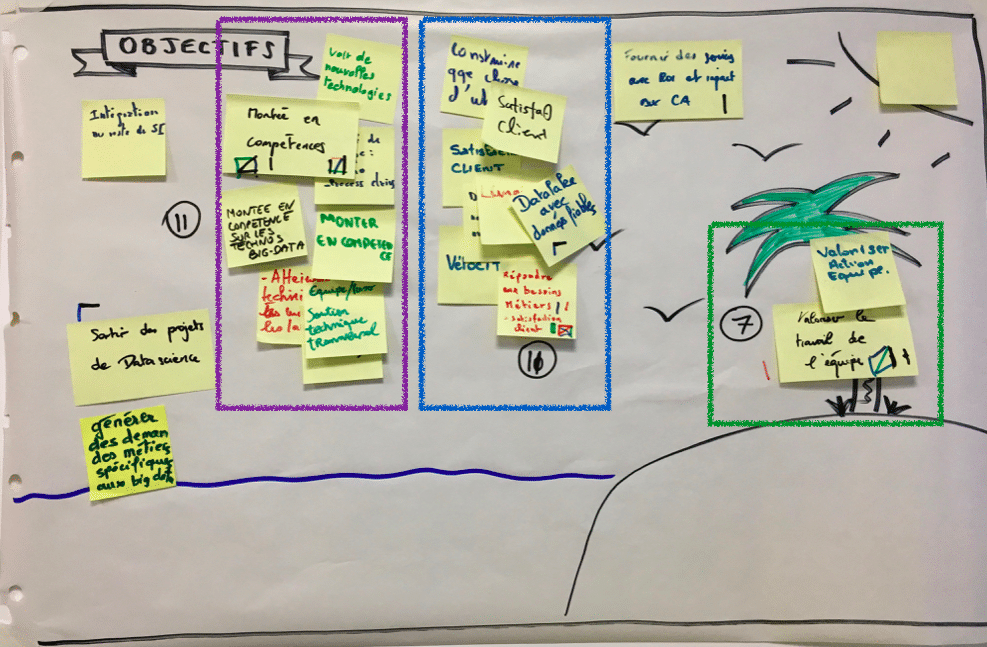
Montée en compétence
- Comment rendre visibles les compétences disponibles au sein de l’équipe ?
- Comment mesurer la montée en compétence des membres de l’équipe ?
- Comment les membres de l’équipe peuvent-ils choisir la/les compétences sur lesquelles s’améliorer ?
Satisfaction client, fiabilité, utilité
- Comment mesurer la satisfaction client ?
- Quels en sont les critères ?
- Comment s’assurer de l’utilité des actions mises en oeuvre ?
- Comment s’assurer de la fiabilité des données ?
- Comment impliquer les clients dans votre mode de fonctionnement ?
Valorisation du travail de l’équipe
- Comment célébrer les résultats atteints de l’équipe ?
- Comment valoriser en interne le travail effectué par l’équipe ?
- Comment valoriser en externe le travail effectué par l’équipe ?
- Comment permettre à l’équipe de se sentir valorisée ?
L’équipage
L’analyse qui suit comprend 2 éléments :
- une description factuelle de ce que j’ai observé sur le dessin
- mes suppositions et questions en vue d’une stratégie d’accompagnement
1 – Au milieu près du mat : c’est le chef de projet
- Il est intéressant de voir que son personnage s’accroche au mat du bateau :
- Est-ce lui qui mène le bateau ou se laisse t-il porter par le bateau ?
- Sa posture est-elle adéquate vis à vis de l’équipe ?
- Le passage à un mode Agile a t-il changé des choses pour lui ?
- Si rien n’a changé, en quoi fait-il partie du problème ?
2 – En haut du mat sur la voile : c’est le N+1
- le personnage est installé sur la voile et non pas sur une structure stable :
- Est-ce qu’il prend bien conscience de l’importance de son rôle ? (dans le sens porteur de la vision et garant du cadre)
- Son rôle est-il bien clair pour tout le monde ?
- Est-il acteur pour mobiliser son équipe vers cet horizon ou reste t’il observateur de l’avancée du bateau ?
- Est-ce qu’un cadre de travail a été défini pour que chacun puisse y trouver sa place et contribuer à atteindre les objectifs ?
- le personnage regarde au loin sans pour autant utiliser de longue vue :
- La vision long terme est-elle claire ou a t-elle été clairement exprimée ?
- Existe t-il une vision à court et moyen terme ?
3 – Au bout du bateau, devant.
- 2 personnages distants du reste du groupe, point intéressant car ces 2 personnes étaient effectivement à distance. Elles ont exprimé leur impression de fournir des efforts sans pour autant avoir d’impact sur l’orientation du bateau – ce qui explique bien leur positionnement :
- Comment la distance est-elle gérée au sein de l’équipe ?
- Quels sont les outils mis en oeuvre ?
- Ces personnes à distance ont-elle un rôle spécifique ?
- La place de ce rôle dans la chaîne de valeur est-elle bien claire pour tous ?
- La communication est-elle fluide entre membres d’équipe non co-localisée ?
4 – Embarquement sur le bateau d’une autre barque
- une idée de mouvement, de dynamique – j’apprends d’ailleurs que cette personne prendra le rôle de lead technique :
- Comment cette personne est-elle perçue par les membres de l’équipe ?
- Comment donner la possibilité à cette personne de partager son dynamisme au sein de l’équipe ?
- Comment l’aider à prendre sa place de manière pertinente ?
5 – Une autre barque, en observation de l’équipage
- la barque est distante par rapport au bateau mais proche de la barque du personnage précédent :
- Y a t-il un lien particulier entre ces personnes (peut-être de par leur différence ?) plutôt qu’avec le reste de l’équipe ?
- Comment faire passer cette personne de la posture d’observateur à celle d’acteur ?
6 – A l’arrière, en train de faire du cerf-volant
- le personnage regarde également vers l’arrière
- Est-il autonome / indépendant par rapport au reste de l’équipe ?
- Sa contribution est-elle explicite et claire – pour lui et les autres – vis à vis des objectifs de l’équipe ?
- A t-il une idée de la vision de l’équipe ? En effet, il peut être difficile de la connaître si on ne s’y intéresse pas.
- Comment l’inviter à contribuer pour le collectif ?
7 – Personnage avec une guitare
- c’est une personne qui vient d’arriver et qui ne sait pas encore trop quoi faire, alors elle met l’ambiance !
- le personnage est bien sur le pont avec l’équipage
- Comment donner du sens à la contribution de cette personne ?
- Comment fait-elle pour ne pas savoir comment contribuer autrement qu’en mettant l’ambiance ?
- Qu’est-il mis en place pour intégrer les nouveaux arrivants ?
8 – Dans la cale du bateau
- ces personnes rament mais non aucune vision de là où elles vont
- le choix de la cale : un signal fort
- comment donner de la visibilité sur les efforts à fournir ?
- comment partager les priorités afin de pouvoir adapter l’effort ?
- comment redonner du sens pour réduire les frustrations et « sortir » la tête de l’eau ?
9 – Dans la cale mais légèrement en avant
- Pas de véritable vision non plus
10 – Sous la voile
- un positionnement « là où il y a de l’espace »
- Comment intégrer la contribution de cette personne au collectif ?
- Connaît-elle son rôle dans l’équipe ainsi que dans la chaîne de valeur ?
- Quel cadre est mis en place pour intégrer cette personne dans l’équipe ?
11 – La barque derrière le bateau
- le personnage est dans une barque séparée mais en contact avec le bateau :
- Pousse t-il le bateau vers l’avant ou évite t-il qu’il ne recule ?
- Pourquoi une barque séparée malgré le contact fort ?
- Quel est son rôle pour le collectif ?
12 – A l’arrière avec une rame
- le personne peut avoir un impact sur l’orientation du bateau sans pour autant avoir de vision au loin
13 – Sur l’iceberg, faisant des signes à l’équipage.
- Le personnage est sur l’iceberg donc pas sur le bateau
- Qu’est-ce qui fait que cette personne se sent hors de l’équipe ?
- Quel est son positionnement ?
- Son rôle est-il connu et valorisé au sein de l’équipe ?
Vents porteurs
La partie Vents porteurs ne sera pas ici très longue. En effet, même s’il me paraît intéressant de réfléchir à comment faire pour maintenir ou intensifier les forces de l’équipe, je l’utilise souvent pour souligner les points positifs de la situation actuelle de l’équipe.
Une chose intéressante est néanmoins arrivée dans mon cas d’étude : des noms de personnes sont apparus, en remerciement de ce qu’elles apportaient à l’équipe ! 🙂
- Quelles sont les histoires qui ont généré ces remerciements ?
- Comment capitaliser sur ces personnes considérées par l’équipe ?
- En quoi contribuent-elles à la situation actuelle de l’équipe ?
- Comment en faire des alliés afin d’avoir plus d’impact ?
Ancres
Après avoir priorisé les ancres, voici les 3 catégories qui ont émergé :
Problèmes de communication, réactivité réponses, nombreux outils
- Sous quelles formes apparaissent ces problèmes de communication ? (manque d’informations, incompréhension, surplus d’informations…)
- Comment rendre visibles les demandes d’information afin d’améliorer la réactivité ?
- Comment mesurer l’impact du manque de réactivité dans les réponses ?
- Existe t-il une liste de tous les outils en place et de tous leurs usages ? Sont-ils tous indispensables ? Sont-ils partagés entre les membres de l’équipe ?
Éparpillement technique, lacunes techniques
- Existe t-il une liste de toutes les technologies utilisées au sein de l’équipe ?
- Est-ce clair pour les membres de l’équipe de l’utilité de chacune d’entre-elles ?
- Est-il vraiment pertinent d’adresser toutes ces technologies ?
- Quelles sont les technologies indispensables à connaître pour votre métier ? Serait-il possible de les hiérarchiser / prioriser ?
- Quel pourrait être le socle commun de connaissances techniques de chaque membre de l’équipe ?
Quelle organisation ?
- Existe t-il une cartographie des acteurs / interlocuteurs intervenant dans le périmètre de l’équipe ?
- Comment s’assurer d’avoir le bon interlocuteur selon la problématique de l’équipe ?
- Les interactions avec les autres équipes sont-elles claires pour l’ensemble des membres de l’équipe ?
Remarques générales
Vision
Le besoin d’une vision claire a été fortement exprimée :
- comment la communiquer à l’équipe afin de l’aider à prendre de meilleures décisions ?
- comment s’assurer que les sujets traités répondent bien à la vision / mission de l’équipe ?
- comment s’assurer qu’un élément est bien terminé ?
Cohérence globale
Le positionnement sur le bateau a mis en exergue le fait que les membres de l’équipe ne se sentent pas tous faire partie du même équipage. Les différentes « barques » indiquent qu’il y a donc un manque de cohérence globale (probablement lié au flou de la vision / des objectifs) :
- comment faire travailler les personnes ensemble plus souvent ?
- comment rendre visible l’ensemble des demandes avant de les accepter ?
Sentiment d’isolation
Les personnes à distance ont exprimé leur sensation d’être isolées face à leurs problématiques :
- comment renforcer l’état d’esprit d’équipe en incluant les personnes à distance ?
- comment s’assurer que la distance soit le moins possible un facteur ralentisseur de productivité ?
- quelles sont les interactions pertinentes entre les membres de l’équipe sur site et à distance ?
Conclusion

Voilà pour cette première étude de cas !
Bien évidemment, les listes de questions ne sont pas exhaustives mais devraient vous permettre de comprendre l’état d’esprit. J’espère en tout cas que cela aura pu éclairer quelques lanternes, générer des idées ou des pistes de réflexion que ce soit en tant qu’accompagnant ou en tant que membre d’équipe !
N’hésitez pas à me dire si ce genre d’exercice vous paraît intéressant et si vous avez d’autres idées – quitte à échanger avec vous sur vos Speed Boats 🙂

